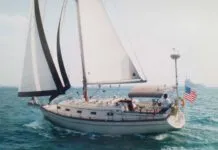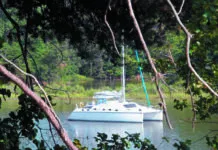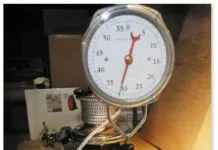
Anchoring can be an emergency situation, even in a harbor. Several years ago I headed out for an afternoon sail, after ticking off a few boat tasks. A hundred yards into the passage between the
entrance jetties, one of the engines conked out. I tried the key and it wouldn’t even cough, but I reasoned it was just a minor warm-up problem that I would sort out in a few minutes once I was in open water. Unfortunately, its twin conked out less than a minute later, just short of the exit. There was a brisk 25-knot crosswind and I calculated that by the time I fussed with restarting them I would surely be on the rocks. The solution was to anchor immediately; there was enough room and time if I executed every step correctly and expeditiously.
- Momentum. The boat was still moving forward at 5-6 knots, providing me considerable latitude to coast into an advantageous position. If I had wasted time puzzling out why the engines stopped, I would have drifted too close to the leeward jetty for anchoring to be an option. Instead, I took advantage of what momentum I had to maneuver the boat as close to the windward jetty as practical. Act quickly, because momentum won’t keep. Each time you anchor, note how far your boat carries into the wind, until you create a database covering a range of conditions.
- Quick Deployment. In harbor settings the anchor should be ready to go within a matter of seconds. Any lashings for offshore sailing should be removed and the anchor should be secured by only a quick-release pin or simple lock. Because I had only to remove a spring clip and pull a pin, I was able to calmly walk to the bow and release the anchor before the boat began drifting backwards.
- Scope. While it’s tempting to begin snubbing the rode at short scope to see if the anchor is catching, resist the temptation. Nothing more than the lightest hand setting should be attempted until scope is at least 7:1. Remember, you’re in a harbor and it’s probably shallow, so it won’t take that long to achieve 7:1 scope. You want it to set and hold the first time. Allow for rode stretch and setting distance.
I was singlehanding, as I often do, but that didn’t make a difference. Anchoring should be a one-person job, where no two actions need to be performed at the same time. Practice until you can do it quickly, without preparation.
I was anchored squarely across the channel, but it was a weekday without traffic. Once satisfied that the anchor was holding, I was free to focus on the engine problem. I lifted the port engine cover and within moment suffered a classic face-palm moment; when I changed fuel filters that morning I forgot to re-open the filter isolation valves. The gasoline in the carburetors and line was just sufficient to propel me between the jetties. Always run the engines for 10 minutes after any engine work, no matter how simple, before heading out!

2. This Fortress is ready to deploy, but unfortunately, this style of anchor is a poor brake, since the design tends to ‘plane’ if you are moving too fast.
3. Assemble adjustable-fluke anchors to match the bottom long before you need to use them.
Several years later I backed out of a slip in a small fishing village, right into a mess of floating fishing gear that had just drifted behind the boat, tangling both props. I didn’t have a lot of time, probably only 30 seconds, before the 2-knot tide swept me into a row of boats. However, there was enough time to throw the rudder hard over to spin the boat 90 degrees, walk to the front of the boat, and lower the anchor. After drifting 100 feet, I gently snubbed the rode, checked for holding, and went for a quick swim (tricky in such current) to unwind the ropes. Another tragedy narrowly averted.
I often see boats with an anchor on the stern rail. Many are used for fore-aft anchoring, but a good many believe that if the engine fails, this is also their emergency brake. In practice, it may not work. First, you probably won’t have enough distance. Better, use your momentum to coast in a direction of safety. This will also slow the boat. Second, the anchor is not going to catch and hold if you have any significant way on.
A pivoting fluke anchor might plane and not even reach the bottom, and others will just drag at speed. If by some miracle it did catch in the soft harbor muck, the impact force will be immense, on the order of hurricane loads, and the anchor will then drag. PS testing has shown that boat speed over 1.5 knots exceeds the safe working load of chain rode, and a boat speed over 3 knots exceeds the safe working load of rope rode. In both cases, the holding capacity of a newly set anchor will be severely taxed.
Dropping the bow anchor with even a slight turn of the wheel is better; the boat will “club haul,” pivoting within its own length, the turning action dissipating considerable energy. If the situation is really tight, sometimes the best plan is to coast within grabbing range of a windward piling. Get the boat stopped with a quick turn, and place fenders where protection is needed. Now you have bought yourself time to work out a proper solution.
The important thing in each of these examples is that you are stopped, the result of maintaining situational awareness and using stored momentum.
































